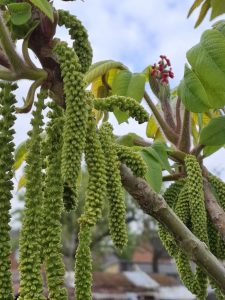Well, following the last two very wet springs this yeas is the polar opposite, until this week we’d had 53mm of rain since December and started irrigating the newly planted trees in March.
Potted trees especially are very susceptible to roots drying out as they’re grown in fast draining commercial composts and although moisture will come in through osmosis most of the time this year there was little to get from the surrounding soil. Bare-root trees are the opposite of this as they have been root pruned and have little fine hair root so need moisture to stimulate root growth, critical when bud break starts.
The actual spring temperatures have been all over the place, upto 20C in March & April and down to around freezing often at night, although very few frosts. This has meant trees in our lower original orchard (86m) have been a bit later in bud break, the mid seasons ones by almost a week although they’ve also accelerated once awake, late ones like Fernor are still tight.
In the new Orchard which is higher (115m) trees have woken up to 7-10 days earlier, they’ve had the warm days but been also warmer at night with the cold further down the slope. This as one of the reasons we picked this field to plant as it wasn’t great for anything other than grass/clover, Lucerne just doesn’t last here as it’s too heavy. We didn’t expect the extra warmth and seasonal advance to be as pronounced though, we’ll see if that’s a regular thing or a one off.
What the lack of frosts this year (all finger and toes crossed still on 26 April) has meant is that all the small heartnuts, black walnuts, Carya etc have had a good uninterupted start, some years our late frosts have caused no end of die back and little growth. All the non J. regia cultivars and Carya are early to mid season bud break (in English walnut terms), none are as late to wake up as the late regia cultivars like Franquette, Fernor etc, probably due to the lack of commercial breeding in all these species.
You might think that walnut species from colder latitudes would be later to bud break but even Manschurica, Ailantifolia, Sigilata collected from colder climates just wake up in our climate all around the same time. Some Heartnuts for example even when listed as ‘latest’ into leaf all seem homogenous here, differences are measured in days, apart from an odd early starter. The image below is of Schubert which is the earliest into leaf and flower, this year there could be some self-fertility as well.

I document all bud break and flowering as often as I’m able even with very young trees, this allows us to build a DB of information to fill in all the very large gaps in information, not just in our country but world wide. Hopefully future plantings will be based on more cerain knowledge than the ‘plant and hope’ method!
Our peculiar maritime climate and a fairly high latitude means we have a lot of seasonal variation affected by the previous summer, winter and then spring each year, no two years are ever the same. All we can say at this stage is that our male pollination is probably more susceptible to seasonal change than the females flowers which seem more consistent regardless of seasonal differences. This has had the effect of us making efforts to source later pollinators for trial here in the hope that we’ll have good coverage as the trees mature. Most information out there is also very anecdotal and site specific so just because a cultivar in Denmark for example is very late doesn’t mean it will continue that pattern in quite the same way here.
